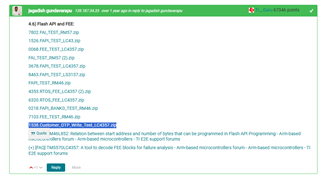Other Parts Discussed in Thread: TMS570LC4357
Tool/software:
Dear TI Team
What is the principle behind the one-time programming of the FLASH OTP area of the TMS570LC4357 chip? Is it software protection or hardware-level design that ensures this?
This thread has been locked.
If you have a related question, please click the "Ask a related question" button in the top right corner. The newly created question will be automatically linked to this question.
Tool/software:
Dear TI Team
What is the principle behind the one-time programming of the FLASH OTP area of the TMS570LC4357 chip? Is it software protection or hardware-level design that ensures this?
Hi Sam,
It is hardware level design protection.
The OTP region is implemented using Flash memory technology that allows one-time writing but permanent storage. Once a bit in this region is programmed from a '1' to a '0', it cannot be changed back. That means we cannot erase or reprogram this area, that means even if we erase entire flash area this area won't be affected. So, we should carefully write into this area.
You can find example project for OTP writing here:

--
Thanks & regards,
Jagadish.
Hi Sam,
After writing data to the flash OTP area, will the data remain intact even under extreme conditions? (0--->1)
Yes, once data is written to the Flash OTP area, it will remain intact even under extreme conditions. and cannot be changed from 0->1 due to hardware level protection in flash memory design.
In addition, could you briefly explain the principles of hardware-level protection?
The OTP region uses the embedded flash technology with special control logic that ensures one time programmability at hardware level.
Flash cells store charge on floating gate. Writing logic-0 adds charge to the gate, and erasing (restoring to logic-1) removes the charge. This will happen in normal flash regions, whereas the OTP regions are physically blocked from erasing - this logic is fused at silicon level only.
You can use this OTP regions to store device serial numbers, security keys etc, once written the data cannot be modified, ensuring device integrity.
--
Thanks & regards,
Jagadish.